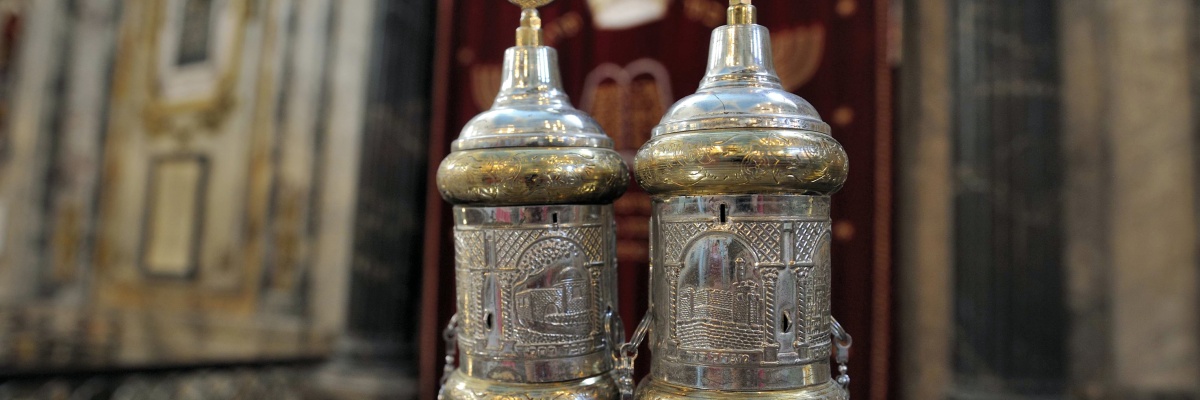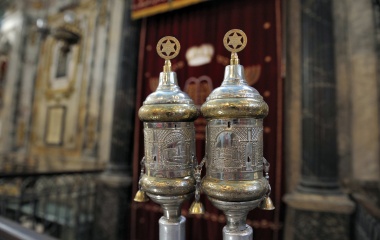
I have often noted that one of most beautiful aspects of the Torah in Motion Journeys through Jewish History is seeing how different communities practice their Judaism in different ways, often quite different from our own. Besides its inherent value it serves to humble us, making us realize the way we were taught to practice Judaism is not the only legitimate way. This is a crucial message, one that would make the Jewish community stronger if we could internalize that message. I hope to continue to discuss some of these differences in my next post; in this post I would like to focus on some of the “philosophical” differences between traditional Judaism as it is understood today, and how many of the greats of the past understood the teachings of Judaism
Travelling from Marseille to Montpellier one passes the city of Posquieres, famous from a Jewish point of view, as the home of the Ra'avad, Rav Avaham ben David, best known for his hasagot, critical comments on the Rambam’s Mishne Torah. Some 13 years older than the Rambam, he fundamentally objected to the goals of and methods of the Mishne Torah. The lack of sources, quoting no other opinion but his own, his assertion that one no longer needed to study Talmud was, as the Raavad correctly notes, a revolution of how halacha is supposed to be decided: a revolution he was not at all in favour of.
Yet he clearly recognized the greatness of the Rambam and could not ignore him. He thus set out to note the errors of the Rambam in short, often acerbic, critiques of many of the conclusions of the Rambam. Perhaps the sharpest of his glosses is in response to the ruling of the Rambam that one who believes that G-d has any physical form is a heretic who loses their share in the world to come (Hilchot Teshuva 3:7). The Raavad comments, “Why does he call such one a heretic? Many greater and better than he followed this opinion”. While the Raavad often disagreed with the Rambam he surely did not consider the Rambam a heretic.
Such could not be said regarding many other rabbis of the time. One of common medieval rabbinic names is Min Hahar. That is because the city of Montpellier, getting its name from having been built on a hill, was the home to many great rabbinic figures. These were rabbis who came from the mountain, min hahar. Likely the most important historically was Shlomo Min Hahar and while I suspect many reading this may be unfamiliar with him, I am sure that most have heard of the controversy he sparked.
In 1232, 28 years after the death of the Rambam, Rav Shlomo Min Hahar, initiated the second and most important of the four stages of the Maimonidean controversy. Horrified by the Rambam’s embrace of Aristotelian philosophy, his allegorizing of parts the Torah, his view on the world to come, his non-literal understanding of Talmudic aggadot, his reasoning for many of the mitzvot – by placing them in historical context it was argued, he was limiting the timelessness of the Torah – he issued a cherem, a ban, on the Rambam and all who would study his works. His student, the famed Rabbeinu Yonah of Gerondi who joined in signing the ban, was sent to gather additional signatories to the ban. Shlomo Min Hahar then led – either personally or via the Church – the burning of the Rambam’s works. Needless to say, this aroused fierce opposition and the supporters of the Ramban excommunicated the anti-Maimonideans. It is related that after the 24 “truckloads” of the Talmud were burned in Paris in 1240 Rabbeinu Yonah realized what a terrible mistake he had made and sought repentance. He vowed to travel to Israel to the grave of the Rambam to seek forgiveness, a vow that was never fulfilled.
Compared with those of some other Sages of Provence the Rambam’s view were quite mild. Yosef Ibn Caspi made many upset by following in the belief of the Greeks that the world was not created yesh me’ayin, something from nothing, but has eternally existed[1]. This view was not necessarily his most radical. Taking the Rambam’s view that certain mitzvot were given as a response to the historical times in which the Torah was given one, or maybe many, steps further Ibn Caspi claimed that the Torah included ideas that are actually false but reflected the beliefs of the ancients. The command for the Jewish people in Egypt to put blood on their doorposts was, to cite one example, due to the ancient superstition that blood had magical properties. By putting blood on the doorposts the people felt reassured they would not suffer the fate of the Egyptians.
Yet that is unlikely the most radical – for Judaism as is generally understood today – view of the Provencal scholars. Such was held by Rabbeinu Levi ben Gershom, known in Jewish history as the Ralbag, and in general history as Gersonides. He was one of the most, perhaps the most, important scientist of his day. Among his many achievements he was the inventor of Jacob’s staff an instrument to measure the angular distance between celestial objects.
He is one of three Jews who have a crater named for them on the moon, Rabbi Levi. His commentary on Tanach was of such quality and beloved that it was included in many editions of the Mikraot Gedolot.
The idea that G-d has limitations would strike observant Jews today as nothing less than total heresy. But not so for the Ralbag and others who followed in his footsteps – and there were others. By granting man free choice – without which the entire notion of mitzvot makes little sense – G-d, by definition, had to limit his foreknowledge of man’s actions. If G-d were to know what one will do then one no longer has free choice. While this may sound jarring to many it is the simple meaning of the verses in the Torah where it seems like G-d did not know what will be. Is this not the simple explanation of G-d, after witnessing generation after generation of man’s sinning, regretting having made man whose nature is to do evil from his youth?
What is so important about the above – even for those with no interest in philosophy – is that those who espoused such views were not written out of our tradition. For good reason they have all earned their rightful place in the annals of the great Jewish thinkers and teachers. We would do well to learn from them.
[1] The Rambam in the Guide writes that had he believed that the world was eternal he would have re-interpreted Breisheet bara Eloheem, In the beginning G-d created. He just did not believe the Greeks were correct. Some claim the Rambam actually did believe in the eternity of the world, or in the eternity of matter from which the world was created, but hid his true views something he readily admits to in his introduction to the Guide.

